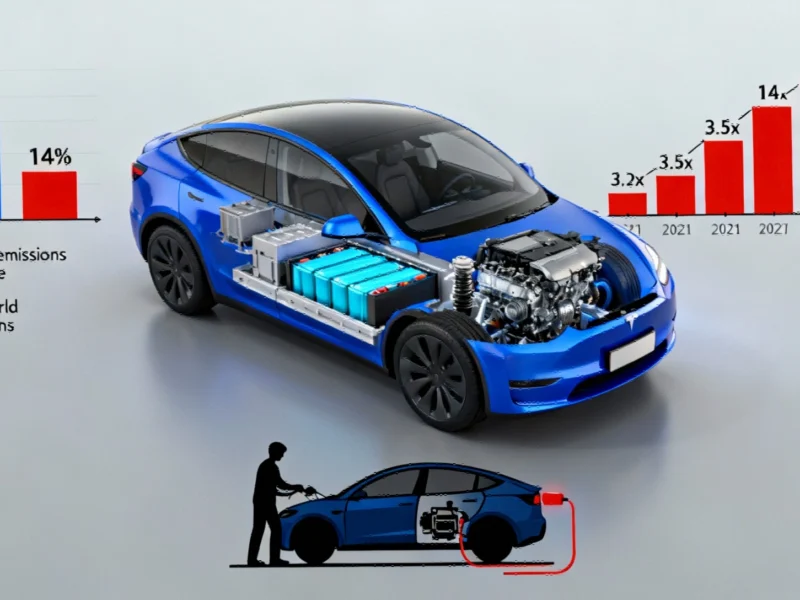Plug-in hybrid electric vehicles have long been marketed as the ideal transitional technology for environmentally conscious drivers—offering electric vehicle benefits without range anxiety. However, new research reveals these vehicles may be contributing to a significant climate accounting problem, with real-world emissions far exceeding official estimates and raising questions about their environmental credentials.
A comprehensive study from Brussels-based Transport & Environment examined hundreds of thousands of European vehicles registered between 2021 and 2023, uncovering a troubling discrepancy between laboratory tests and actual emissions. Where regulators previously assumed PHEVs emitted 75% less carbon than conventional vehicles, the reality appears dramatically different—just 19% less than internal combustion engines. As recent analysis confirms, this gap between official figures and real-world performance represents a substantial challenge for climate policy.
The Widening Credibility Gap
What researchers describe as “quite a scandal” extends beyond mere statistical differences. The gap between official emissions estimates and real-world performance has been steadily increasing—from 3.5 times higher than official estimates in 2021 to nearly five times higher by 2023. This progressive divergence suggests systemic issues in both vehicle design and regulatory methodology.
Yoann Gimbert, co-author of the study, emphasizes the significance of these findings: “I think it’s quite a scandal to have this gap between real world and official data.” The implications extend beyond environmental concerns to touch on consumer trust and regulatory integrity.
The Utility Factor Fallacy
At the heart of the discrepancy lies what researchers call the “utility factor”—the percentage of miles driven using electric power versus the combustion engine. European Union estimates assumed PHEVs would operate in electric mode over 84% of the time, but real-world data reveals a dramatically different picture: just 27%.
Several factors contribute to this underperformance. Gimbert notes that European drivers lack sufficient incentives to prioritize electric operation, compounded by limitations in fast-charging infrastructure and relatively lower power output from electric motors in hybrid configurations. This pattern mirrors other industries where performance expectations don’t always align with practical usage patterns.
The Engineering Reality: Never Fully Electric
Perhaps most revealing is the researchers’ discovery that plug-in hybrids cannot operate as fully electric vehicles even when selected in “electric mode.” The internal combustion engine continues providing significant additional power, burning fossil fuels during acceleration, high-speed driving, and hill climbing—accounting for at least one-third of propulsion even in supposed electric operation.
“It’s actually 68 grams of CO2 per kilometer in electric mode, instead of being zero emission,” Gimbert explains. This figure represents nine times the 8 grams per kilometer estimated by EU methodology. “That’s something that is often not really expected by consumers,” he adds, highlighting the information asymmetry between manufacturers and buyers.
Regulatory Response and Industry Resistance
The European Union has acknowledged the problem, announcing corrections to its utility factor measurements and preparing for a comprehensive review of carbon emissions standards next year. However, researchers caution that even with these adjustments, real-world emissions would remain 18% higher than official figures without more substantial reforms.
The automotive industry, particularly through the German Association of the Automotive Industry (VDA), is lobbying aggressively against these changes. Industry representatives seek to maintain current methodology and roll back the planned 2035 combustion engine ban. This resistance comes amid findings that underestimated PHEV emissions have allowed major manufacturers including Volkswagen, Mercedes-Benz, and BMW to avoid approximately €5 billion in fines between 2021 and 2023.
Broader Implications and Market Context
The plug-in hybrid emissions discrepancy has significant consequences for climate targets. Researchers project that if industry lobbying succeeds, carbon emissions could increase by 64% by 2050 under current regulations. “PHEVs are not fitted for 100% emission reduction by 2035,” Gimbert concludes, suggesting these vehicles may not represent the climate solution they’re marketed as.
Meanwhile, in the United States, where electric vehicle demand shows signs of plateauing amid high prices and reduced tax incentives, hybrids and plug-in hybrids are gaining attention as alternatives. However, the stagnant demand for PHEVs specifically suggests consumers may be recognizing their limitations. This automotive reassessment parallels other sectors where initial technological promises require careful evaluation against real-world performance.
Looking Forward: Transparency and Accountability
The plug-in hybrid emissions gap represents more than just a technical measurement issue—it highlights the challenges of transitioning to cleaner transportation amid competing economic interests and regulatory complexities. As the automotive industry evolves, the need for transparent testing methodologies and accurate consumer information becomes increasingly critical.
This situation reflects broader patterns in industrial technology adoption, where major corporate restructuring often follows reassessments of environmental impact and operational efficiency. The coming year’s EU regulatory review will likely set important precedents for how governments balance environmental goals with industrial realities in the transportation sector.
Based on reporting by {‘uri’: ‘gizmodo.com’, ‘dataType’: ‘news’, ‘title’: ‘Gizmodo’, ‘description’: ‘We come from the future.’, ‘location’: {‘type’: ‘place’, ‘geoNamesId’: ‘5128581’, ‘label’: {‘eng’: ‘New York City’}, ‘population’: 8175133, ‘lat’: 40.71427, ‘long’: -74.00597, ‘country’: {‘type’: ‘country’, ‘geoNamesId’: ‘6252001’, ‘label’: {‘eng’: ‘United States’}, ‘population’: 310232863, ‘lat’: 39.76, ‘long’: -98.5, ‘area’: 9629091, ‘continent’: ‘Noth America’}}, ‘locationValidated’: False, ‘ranking’: {‘importanceRank’: 174039, ‘alexaGlobalRank’: 1756, ‘alexaCountryRank’: 545}}. This article aggregates information from publicly available sources. All trademarks and copyrights belong to their respective owners.

